How to choose a pump for the pool: a comparative overview of different types of units
Do you want to equip your own pool by creating a paradise from it? And therefore, choose a pump for the pool, but the range is so large that it is difficult to stop on a particular model? Agree, it’s nice to get a unit that will be inexpensive, but at the same time can satisfy your needs. Which is better: to provide clean and warm water in the pool or turn your pond into a jacuzzi?
We will help you choose the best option - the article discusses the main types of pumps used for pools, their characteristics and capabilities. Also provides reviews of popular models with sand filters for heating water and creating a counterflow.
To make it easier for you to choose your version of the pump, we have selected videos that clearly demonstrate the capabilities of the considered units, and photos. Many of the models are able to solve various problems, helping to turn the pool into a remarkably equipped artificial pond for a pleasant rural vacation.
The content of the article:
What is the pump in the pool for?
A pump is a device for pumping liquids. The number of pumping devices in the pool depends on the complexity of the entire pond system and the volume of water.
The abundance is also affected by the presence of special zones: spa, hydromassage, fountains, sports, and attraction areas.
Several types of pumps are involved in the maintenance and normal operation of the pool:
- Pump for pumping water. It is required to fill an artificial reservoir, to empty the tank in case of repair, sanitary care, conservation for the winter.
- Circulation pump. Providing movement of water to cleaning and heating units and vice versa.
- Heat pump. It is used in the case of an alternative thermal energy production system instead of the traditional heating option.
- Counterflow pump. It is used in the organization of hydromassages, water rides, waterfalls and similar special effects.
All these pumps have their own specifics. The purpose of the following review is to show the diversity and principles of the choice of pumping equipment for the water world of pools.
Types of pumping equipment for the pool
Pumps traditionally used to service pools without specific functions can be divided into centrifugal and vortex pumps according to the principle of operation.
View # 1 - centrifugal and vortex aggregates
In centrifugal pumps, the impeller is a disk with curved blades. Moreover, the blades are bent in the opposite direction of rotation. The pump housing is in the shape of a snail.
With rapid rotation of the impeller, water is carried away by the blades and squeezed to the walls.
As a result, two phenomena occur at once:
- A rarefaction is created in the center, as in a funnel.
- Water moving along the increasing radius of the cochlea shell picks up speed and is pushed out.
Centrifugal pumps are characterized by: low pressure, low noise, large volume of pumped water.
For the pump to work, it is necessary to fill the inlet pipe and the impeller housing with water, since such a system will not push air.
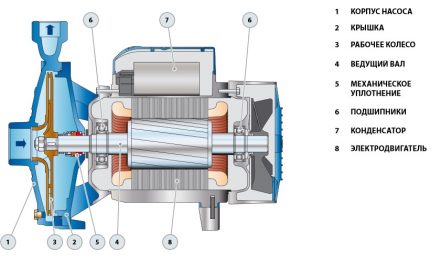
Vortex pumps have a special impeller design called an impeller. The casing of the vortex pump is quite tightly wrapped around the impeller in diameter, but has a gap on the sides.
When the impeller moves, the water flow in the form of vortices swirls on the blades, hence the name.
Due to the small gap, the vortex pump is able to work on a mixture of air and water. Vortex pumps are able to start suction with a small amount of water or without it at all, therefore they do not require filling the pipe before starting work.
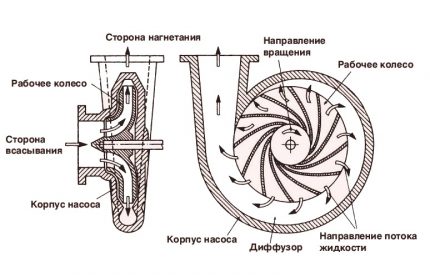
Vortex pumps are characterized by: high pressure at the outlet, increased noise, a small amount of pumped water.
Both types of pumps without additional devices cannot create a vacuum of more than 1 atmosphere, therefore they are limited by a pressure of 10 m, which is quite enough to service the pools.
View # 2 - self-priming pumps
Self-priming pumps are the most common, as they allow you to install them above or below water level. This is especially true for frame and inflatable pools, when it is not possible to place equipment under the pool.
The self-priming pump is capable of taking water from three meters high. However, it should be borne in mind that raising water requires significant energy, so the pump should be installed as low as possible.
When choosing a pump, you must consider:
- The throughput of the filter elements. It should match pump performance.
- Diameter of suction and discharge nozzle.
- The volume of pumped water complies with sanitary standards.
- The possibility of continuous operation.
- Noise level.
- The material of manufacture.
When choosing self priming pump pay attention to the ease of maintenance of the unit. The presence of a viewing window helps to determine the filling of the filter.
Cases of self-priming pumps are made of reinforced plastic, the shaft and fasteners are made of stainless steel.
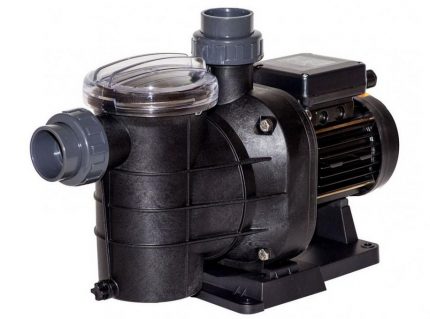
View # 3 - pump with filter element
Pumps with a filter element are most often used for ready-made pools: frame or inflatable. Such devices are equipped with an appropriate filter by the manufacturer.
The simplest water treatment systems can do with just one pump of this type.
Filter elements are of several types:
- sand pumps;
- paper cartridges.
Pumps with paper cartridges suitable for small pools. Paper filters effectively purify water but cannot provide a large volume of water.
In addition, they often have to be changed, which adversely affects the cost of maintenance.
Pumps with sand filter or sand pumps, more efficient and designed for large volumes of water. Water passes through quartz sand and all the dirt, even the smallest particles settle in the sand.
To clean the sand filter, water is passed in the opposite direction and drained into the sewer.
Instead of quartz sand, other adsorbents can be used: glass sand, gravel, anthracite, carbon. Carbon filters are the most efficient.
When choosing a filter adsorbent, pay attention to the duration of work. For example, quartz sand needs to be changed once every three years, and glass sand - once every five years.
Additionally, ozonizers are installed on sand pumps. Ozonizers kill microorganisms and oxidize small particles of dirt, causing them to decay.
The disadvantage of pumps with a filter element is that the two filter devices and the pump are mounted in one housing. When exiting from a standing one of the devices, you will have to buy both.
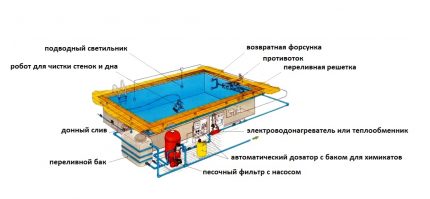
View # 4 - circulating units
The circulation pump is one of the main units necessary for the normal functioning of the pool.
The simplest artificial reservoir can cost one pump of this type. He is responsible for creating a constant flow of fluid through the filter elements.
According to the sanitary standard, the circulation pump must have such a capacity that in a day pump at least 4 times the entire volume of pool water.
As for inflatable or frame pools with one pump, its performance should be about ¼ of the pool volume per hour.
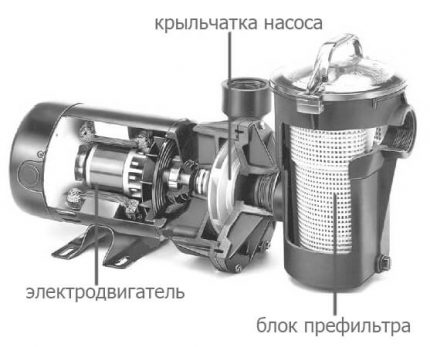
The circulation device used in the arrangement of the pool differs from other types of pumps in two ways:
- The presence of a filter element. It prevents large debris from jamming the impeller of the pump.
- Case material. Resistance of casing materials and technical filling of the pump to corrosion and destructive oxidation due to the use of disinfectant chemicals.
The circulation pump according to the pressure criteria should be selected depending on the degree of complexity of the equipped pool.
A low-pressure machine is enough if it is only planned to move water in a container to distribute antiseptics and direct flows to the filters. Those wishing to organize their own water park should be interested in models with high pressure values.
View # 5 - submersible models for pumping water
To pump water from the pool, you can do with a self-priming circulation pump. It should be borne in mind that self-priming pumps for inflatable and frame pools are not designed for continuous operation.
Manufacturers do not recommend the use of self-priming pumps to drain water more than 1 time per week.
Specialized pumps for pumping water are submersible. They have wide intake windows and are able to pump out contaminated water with particles up to 5 cm.
The pumps have a built-in automatic shutdown system in the absence of water. Able to pump water up to 1 cm or less.
Household drainage pumps universal applications usually have a float shutting off the pump when the water level is 5-10 cm below the height of the pump. They cannot completely pump out water.
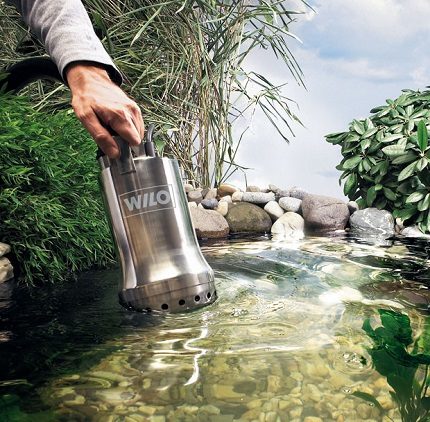
View # 6 - pump modifications without prefilters
Pumps without prefilters are used for large and stationary pools. Characterized by high power and performance.
Such pumps are used for:
- circulation;
- hydromassage;
- waterfalls;
- fountain;
- SPA
Pumps without a pre-filter are used as an addition to an existing system. As an additional circulation pump or for organizing special zones in the pool.
Popular sand filter models
We offer a rating of the most popular pump modifications, which are preferred by owners of private pools around the world.
Model # 1 - Intex
Intex China International Corporation is the largest manufacturer of inflatable and frame pools. Affordable price and high quality, durability - deserved characteristics of Intex brand products.
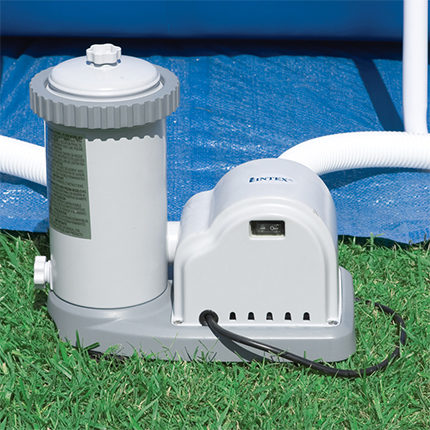
It is applied to small swimming pools.
Main characteristics:
- mains voltage - 220V;
- flow rate - 5600 l / h;
- case material - plastic.
A fully finished pump is mainly used for inflatable and frame pools. It has a threaded connection of nozzles. Used for short, seasonal cleaning and circulation, after which it is stored.
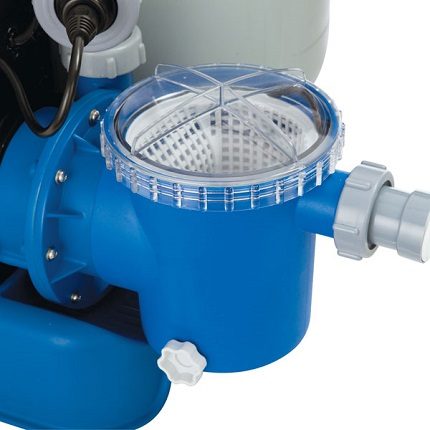
One of the most common options for home use.
Main characteristics:
- mains voltage - 220V;
- flow rate - 8000 l / h;
- case material - plastic.
The pump is equipped with a timer for automatic on-off. The filter can use quartz or glass sand. Connection of branch pipes threaded.

Quite a serious unit for the middle pool.
Main characteristics:
- mains voltage - 220V;
- flow rate - 10,000 l / h;
- case material - plastic.
It produces 11g / h of chlorine, effectively fights against microorganisms, mucus, algae. The main filter element is quartz or glass sand.
Model # 2 - Kripsol
The next Spanish pool equipment manufacturer is Kripsol. The company's products are widely known throughout the world, manufactured in an extensive assortment.

Main technical specifications:
- mains voltage - 220V;
- flow rate - 14500 l / h;
- case material - polypropylene.
The sand filter holds 125 kg of sand. The unit is equipped with a six-position valve. There is a manometer.
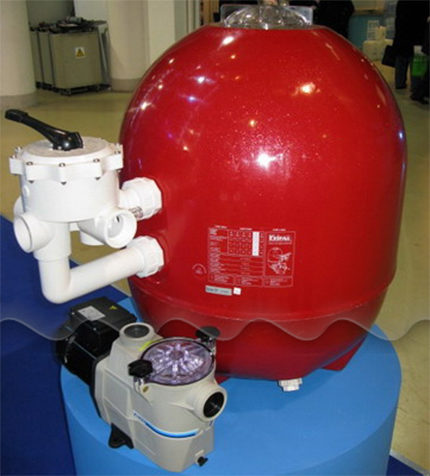
Powerful and durable filter, high-quality materials are used in the manufacture of the pump.
Main characteristics:
- mains voltage - 380V;
- flow rate - 30,000 l / h;
- case material - fiberglass reinforced polyester.
The filter unit is designed for private and not large public pools. The unit is equipped with a multi-way valve for flushing and maintenance.
Model # 3 - Emaux
Hong Kong-based company Emaux is a major manufacturer of swimming pools and equipment for them, the company has offices in 70 countries. The list of products: from pools to attractions.
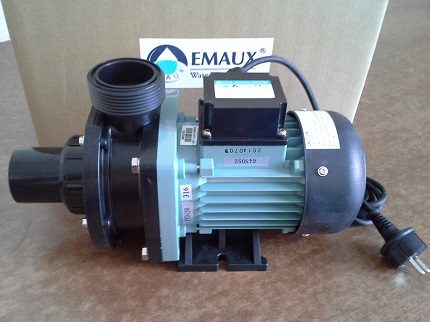
Main characteristics:
- mains voltage - 220V;
- flow rate - 5600 l / h;
- case material - plastic.
The body material is UV and moisture resistant. The installation is equipped with two valves for venting.
The device with a stable base and low weight, suitable for small inflatable pools.
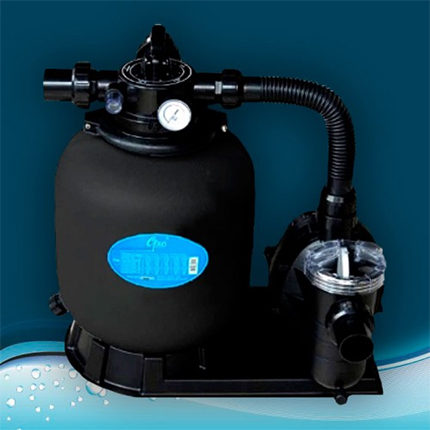
A sand pump is capable of purifying the water to transparency, but microorganisms will remain.
Main characteristics:
- mains voltage - 220V;
- flow rate - 13000 l / h;
- case material - polyethylene.
The volume of the loaded sand is 145 kg. The delivery includes a pressure gauge and a four-position valve. Subtlety of cleaning - 20-30 microns.
Model # 4 - Behncke
Behncke is a German manufacturer of water related equipment. It is one of the highest quality suppliers in the Russian market.
The family business was founded in 1946, and is currently managed by the third generation of owners.
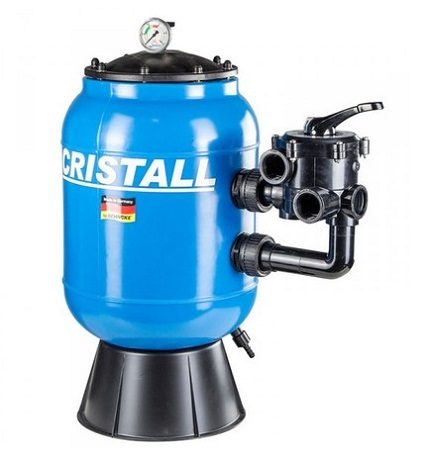
Main characteristics:
- network voltage - 380V;
- flow rate - 32000 l / h;
- case material - polypropylene.
The filtering unit holds 375 kg of sand. A six position valve controls various operating modes. Suitable for pools up to 160 m3. When choosing filter units It is necessary to focus on the cleaning method.
Cartridge and cassette filters are suitable for small volumes of inflatable and frame pools. Easy to maintain and do not require sewage.
Sand filters are suitable for medium and large volumes, up to public pools. They differ in impressive mass, often require a three-phase connection.
Pool heat pumps
In most of our country, summer is coming to an end very quickly. During the night or in cloudy weather, the water in the pool cools.Traditional heaters to heat the pool is expensive.
The principle of operation of the heat pump
Principle of operation heat pump can be clearly seen on the example of a domestic refrigerator. The heat pump includes: heat exchanger, compressor, evaporator.
Freon is circulating in the heat pump system, a gas capable of turning into a liquid state at room temperature. When the phase state of Freon passes, heat is taken from the environment and then the circulating water in the heat exchanger is heated.
In short, the refrigerator is the other way around: the environment is cooled, the water is heated.
According to the interaction with the environment, there are three types of heat pumps: soil-water, water-water, air-water.
Heat pump selection criteria
Each type of pump has its own installation rules for the circuit. For ground-water pumps, horizontal or vertical pipes are required.
In any case, pipes must be laid at a depth of at least 2-3 meters - to the freezing depth. From above it is impossible to plant trees with a powerful root system.
Water-to-water pumps use the energy of water bodies. Such pumps are a profitable option, since they do not require excavation of the previous type of pumps.
In these systems, laying to a depth of freezing of 2-3 meters is also required. The distance from the reservoir to the pool should not be more than 100 meters.
Air-water systems do not require complex piping and are easy to install. However, air-water pumps less effective, since they extract the thermal energy of air and depend on its temperature in a specific time period.
When choosing an air-water heat pump, consider:
- pump installation location (sun or shadow);
- average air temperature;
- pool volume;
- type of pool (outdoor or indoor).
Regardless of the heat pump system selected, approximately 5-8 kW of heat is generated per average kWh of energy consumed. Modern heat pump systems can even heat an outdoor pool year-round.
Overview of heat pump models
The review includes air-water heat pumps, as the most simple to use and do not require special and complex calculations. There is no fundamental difference between heat pumps for home heating and pool heating.
Thermal Unit # 1 - Zodiak
Zodiak is a representative of a French pool maintenance and care company.
It occupies a leading position thanks to the constant introduction of innovative developments, such as a water robot vacuum cleaner.
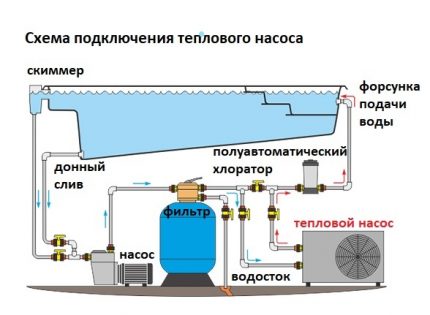
Main characteristics:
- power consumption - 1.6 kW;
- thermal power - 9 kW;
- water flow - 4000 l / h.
The pump heat exchanger is made of titanium. Special electrical and water connectors facilitate installation. The device is equipped with a digital display.
Thermal Unit # 2 - Azuro
Azuro is a trademark of a Czech manufacturer.It specializes in the production of frame pools, equipment and accessories. Especially popular models made specifically for summer cottages.
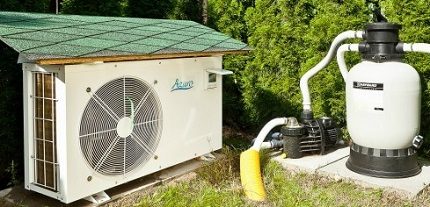
In order not to transfer the heat pump each time, it is installed under a canopy.
Main characteristics:
- power consumption - 1.7 kW;
- thermal power - 8.5 kW;
- the volume of the pool is 20-30 m3.
The heat exchanger material is titanium. Digital display and built-in thermostat. There is a function of automatic defrosting of the evaporator. Simple installation.
Thermal Unit # 3 - Fairland
Fairland is a Chinese manufacturer, founded in 1999. The company specializes in the design and manufacture of thermal equipment. Successfully sells products in more than fifty countries.
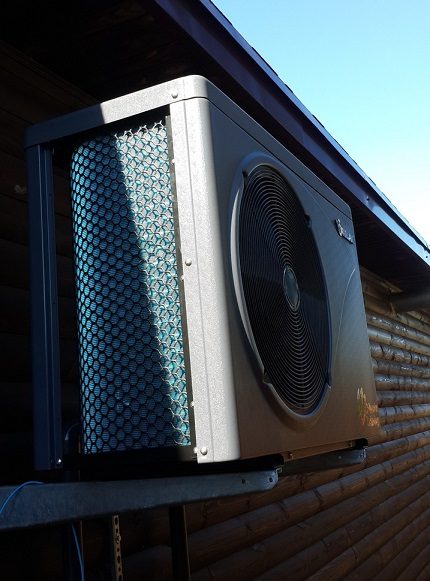
Such a pump can easily be connected to the heating system of the cottage.
Main characteristics:
- power consumption - 1.7 kW;
- thermal power - 7.5 kW;
- water flow - 4000-6000 l / h.
As with previous models, the heat exchanger is made of titanium. Due to the use of invertor technology, it has extended operating conditions: from -7 degrees to +43 ° C.
The device is equipped with a soft start to avoid power surges. All control occurs from the digital panel.
The development of technology every year makes the use of heat pumps more efficient. The average payback of a heat pump is 4-5 years.
Backflow Pumps
With a special pump to create a counterflow, you can swim in a small, home pool. Counterflow pumps come in two forms:
- Mounted. Suitable for small seasonal pools. These are units in which everything is in one: pump, nozzles, lights, handrails, automation and control. Plus this design is easy to install.
- Recessed.Equipped with a suction mechanism that can extract water when located above and below its level. Differ in more expensive and complex design. They are mainly used in the arrangement of stationary pools.
When installing counterflows, attention should be paid to the water level: the level of the counterflow area should be 120-140 mm above the water level.
Counterflow # 1 - Speck
Speck was founded in 1909 in Germany and specializes in the manufacture of pumping equipment for liquid and gaseous media.
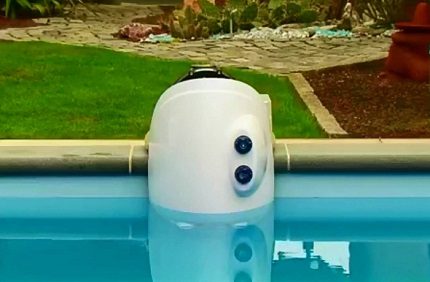
The model has excellent features and a nice design.
Main characteristics:
- power consumption - 2.9 kW;
- productivity - 53 m3.
It is possible to connect special nozzles for hydromassage to the device. Easy to install without damaging the pool wall. There is an adjustment of the amount of mixed air.
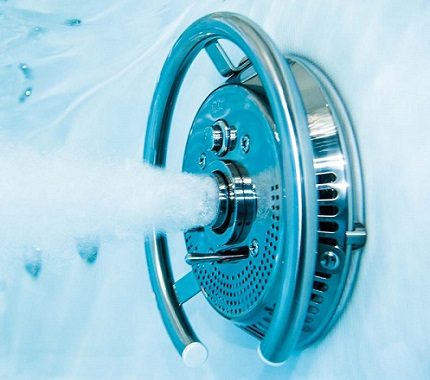
Main characteristics:
- power consumption: 3.3 kW;
- productivity: 58 m3.
The mounted countercurrent have increased power, connected to a three-phase power supply. Designed for maximum loads for athletes. Has a built-in LED spotlight.
Counterflow # 2 - Glong Electric
Glong Electric is a Chinese manufacturer of electric motors and water pumps. The company produces an extensive line of pumps: from cheap plastic to expensive with a bronze body and high performance. The company was founded in the mid-90s.
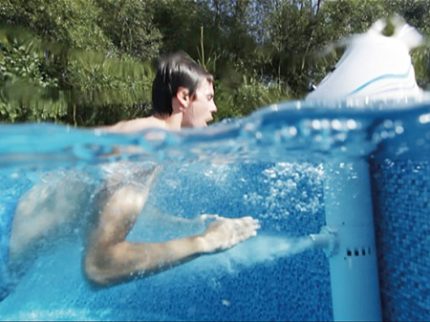
The model is easy to install and carry.
Main characteristics:
- power consumption: 2.9 kW;
- productivity: 54 m3.
A single-jet countercurrent can serve as a hydromassage.To turn the device on and off, it is not necessary to leave the pool; there is a special pneumatic button.
Counterflow # 3 - Pahlen
The Swedish company Pahlen is registered more than 40 years ago. Specializes in the production of equipment for swimming pools. Deliveries to more than 70 countries of the world.
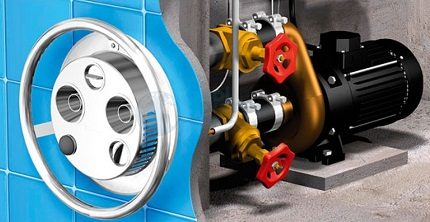
It can be equipped with a mortgage part in the form of a handrail.
Main characteristics:
- power consumption - 2.2 kW;
- productivity - 54 m3.
Requires connection to a three-phase power supply. Made of bronze and stainless steel.
The delivery includes a pneumatic start unit.
You may also be wondering how to organize pool ventilation.
Conclusions and useful video on the topic
Overview of sand pump modes:
Equipping the pool with a counter-current pump pump:
Principle of operation and use of a heat pump:
Choosing a pump to service an artificial reservoir can be very simple: just buy an all-in-one unit.
On the other hand, a huge selection of pumping equipment makes it possible to realize any fantasy from a heated indoor pool to attractions and sports counter currents.
Looking for a pump for the pool and can not decide what? Or maybe there is experience using such equipment and would like to share it with our readers? Please leave your questions and valuable tips in the box below.

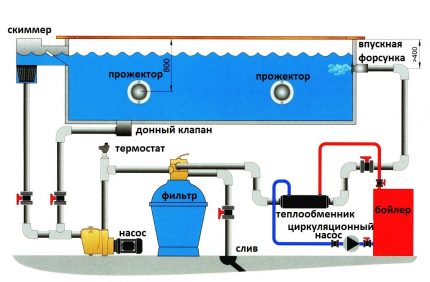
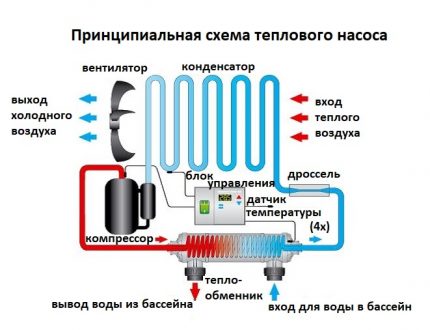
 How to choose a filter for the pool: types of units and the rules for the right choice
How to choose a filter for the pool: types of units and the rules for the right choice 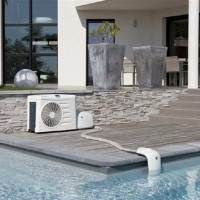 Pool heat pump: selection criteria and installation rules
Pool heat pump: selection criteria and installation rules  Materials for waterproofing pools: a comparative review
Materials for waterproofing pools: a comparative review 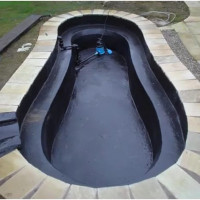 Do-it-yourself pool waterproofing: technology overview + step-by-step example of work
Do-it-yourself pool waterproofing: technology overview + step-by-step example of work 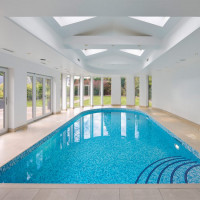 Organization of ventilation of the pool: the best methods of organizing air exchange
Organization of ventilation of the pool: the best methods of organizing air exchange 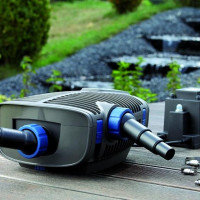 Pumps for fountains and waterfalls: how to choose and install yourself
Pumps for fountains and waterfalls: how to choose and install yourself  How much does it cost to connect gas to a private house: the price of organizing gas supply
How much does it cost to connect gas to a private house: the price of organizing gas supply  The best washing machines with dryer: model rating and customer tips
The best washing machines with dryer: model rating and customer tips  What is the color temperature of light and the nuances of choosing the temperature of the lamps to suit your needs
What is the color temperature of light and the nuances of choosing the temperature of the lamps to suit your needs  Replacement of a geyser in an apartment: replacement paperwork + basic norms and requirements
Replacement of a geyser in an apartment: replacement paperwork + basic norms and requirements
Get to know more about modern swimming mattresses. We will find out which models are designed for water, which ones can be used for sunbathing, and which ones will help to arrange a party in the pool. How to make a successful purchase without overpaying? Let's see how dimensions, equipment, materials, design and prestige of the brand affect the cost.
I have personal experience using an Intex filter. Used it to equip a frame pool with a volume of about 6000 liters. In general terms, the model is good, but there are a couple of minuses that were not mentioned. Firstly, the plastic case - therefore, it is quite fragile. Due to the white color, dirt accumulations are quickly visible on it (although this is not so important). Secondly, even with small power outages, the filter can simply fail. Otherwise, everything works fine - it quickly pumps water, is easy to clean, and easy to use.